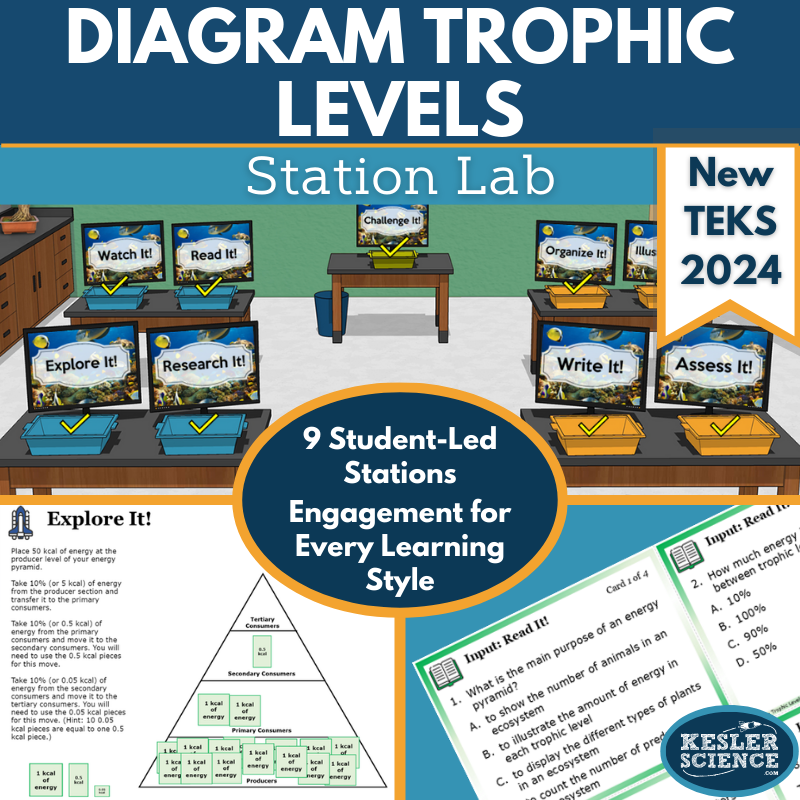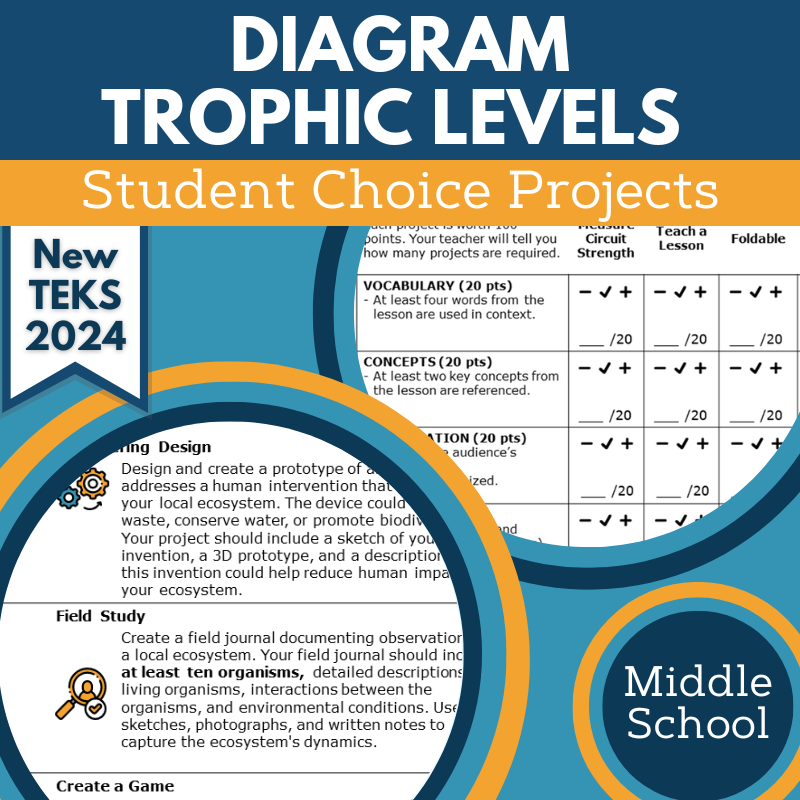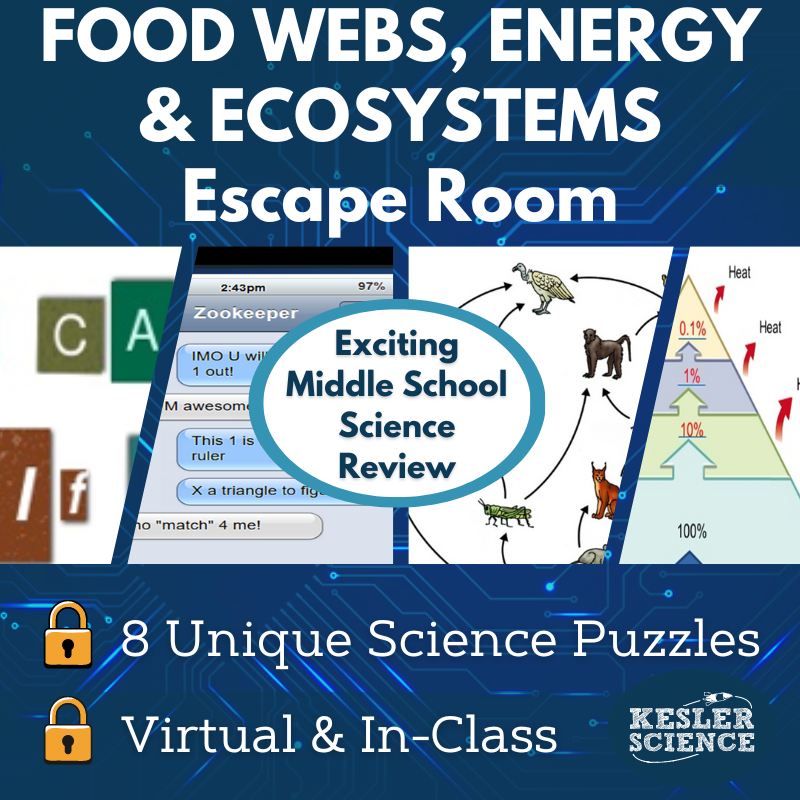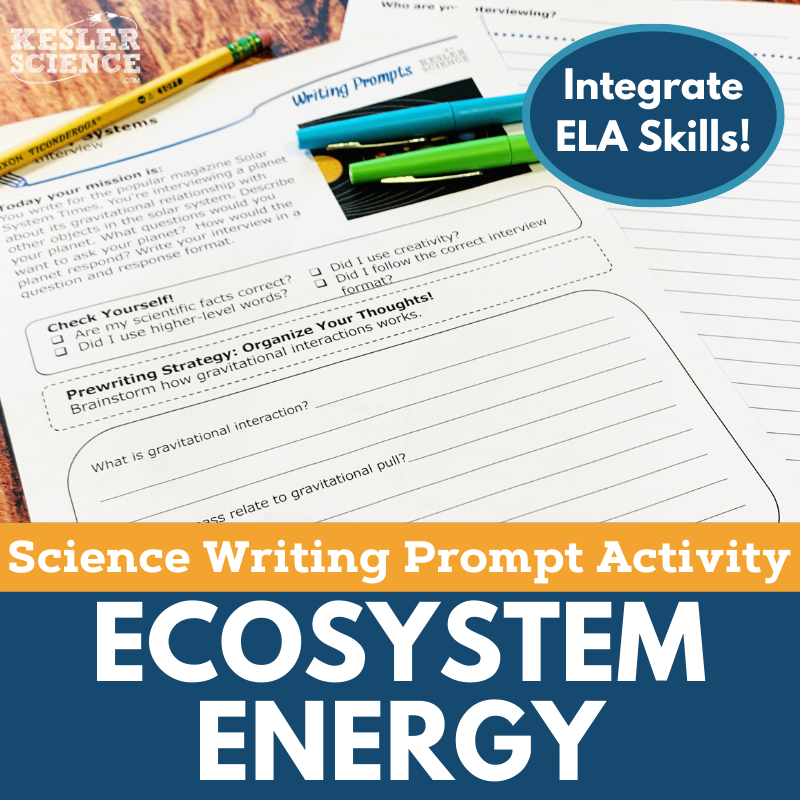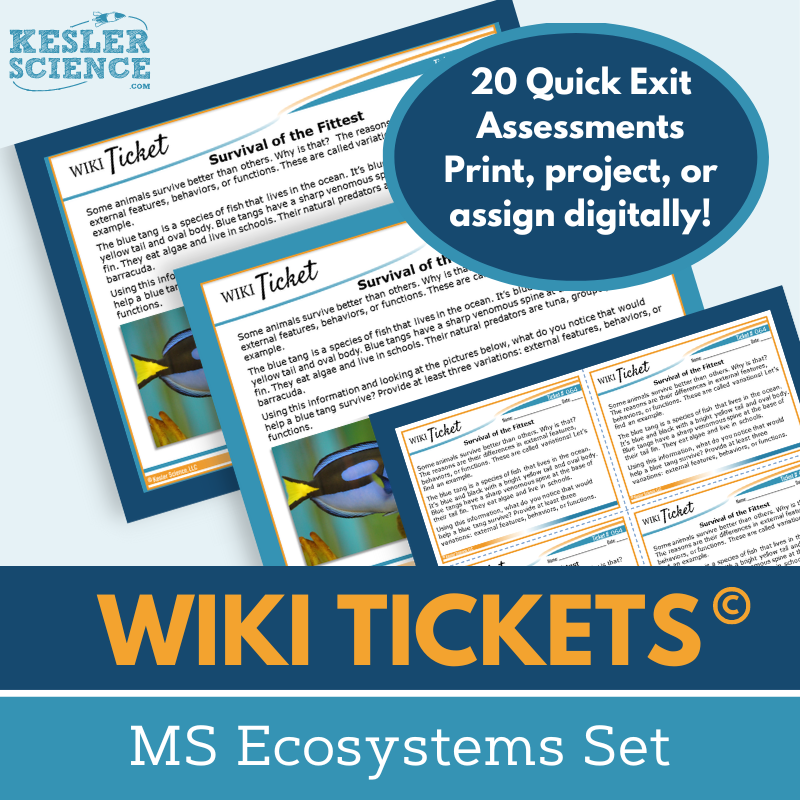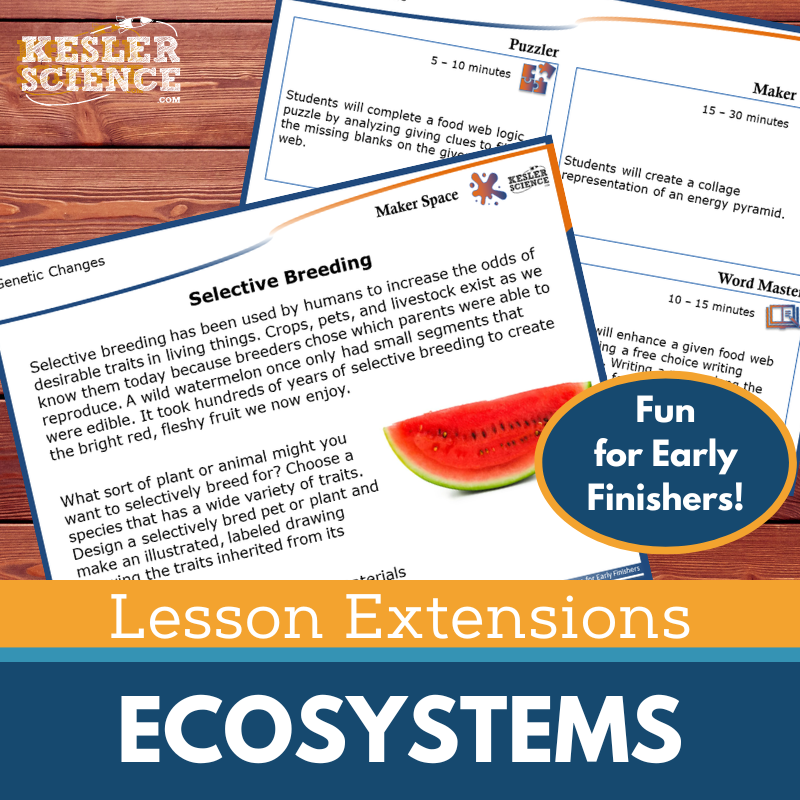Diagram Trophic Levels Activities for Middle School Science
Understanding energy flow through trophic levels is key in ecology, and this engaging 5E lesson helps students master it. The resources below will give students a comprehensive understanding of diagraming trophic levels. All of the following materials are also included in the Kesler Science Membership.
The Kesler Science Diagram Trophic Levels 5E Lesson is a comprehensive unit on diagramming energy flow through trophic levels and understanding energy decreases in energy pyramids. It includes presentations, worksheets, choice projects, and assessments, all fully editable and requiring minimal prep. Designed for differentiated, student-led learning, it aligns with the 2021 TEKS 7.12A standard.
The lesson follows the 5E Model, starting with engagement activities and vocabulary resources in English and Spanish. The exploration phase features a differentiated station lab with nine multimodal stations, helping students grasp producer-consumer relationships and the 10% energy rule. Explanation includes editable PowerPoints, interactive notebooks, and note-taking templates. Elaboration allows students to extend their learning through choice projects, while evaluation provides STAAR 2.0-aligned assessments, review questions, and worksheets.
Flexible for in-class or virtual learning, the materials include printable and digital formats, interactive elements, and Spanish translations. The lesson fosters engagement through hands-on activities, reading passages, research tasks, videos, and creative output stations, ensuring accessibility for all learners.
The Kesler Science Diagram Trophic Levels 5E Lesson is a comprehensive unit on diagramming energy flow through trophic levels and understanding energy decreases in energy pyramids. It includes presentations, worksheets, choice projects, and assessments, all fully editable and requiring minimal prep. Designed for differentiated, student-led learning, it aligns with the 2021 TEKS 7.12A standard.
The lesson follows the 5E Model, starting with engagement activities and vocabulary resources in English and Spanish. The exploration phase features a differentiated station lab with nine multimodal stations, helping students grasp producer-consumer relationships and the 10% energy rule. Explanation includes editable PowerPoints, interactive notebooks, and note-taking templates. Elaboration allows students to extend their learning through choice projects, while evaluation provides STAAR 2.0-aligned assessments, review questions, and worksheets.
Flexible for in-class or virtual learning, the materials include printable and digital formats, interactive elements, and Spanish translations. The lesson fosters engagement through hands-on activities, reading passages, research tasks, videos, and creative output stations, ensuring accessibility for all learners.
Engage your middle school students with this student-led station lab aligned with TEKS 7.12A, focusing on diagramming trophic levels. Designed for in-class or virtual learning, this interactive lesson guides students through the flow of energy within trophic levels and the decrease in available energy across an energy pyramid.
Students explore concepts through nine differentiated stations featuring videos, readings, research, and hands-on activities. They demonstrate their understanding by organizing information, illustrating models, writing responses, and completing assessments. A challenge station provides extension activities, while English and Spanish reading passages support differentiated learning.
This low-prep, high-engagement resource fosters independent learning and critical thinking.
Engage your middle school students with this student-led station lab aligned with TEKS 7.12A, focusing on diagramming trophic levels. Designed for in-class or virtual learning, this interactive lesson guides students through the flow of energy within trophic levels and the decrease in available energy across an energy pyramid.
Students explore concepts through nine differentiated stations featuring videos, readings, research, and hands-on activities. They demonstrate their understanding by organizing information, illustrating models, writing responses, and completing assessments. A challenge station provides extension activities, while English and Spanish reading passages support differentiated learning.
This low-prep, high-engagement resource fosters independent learning and critical thinking.
The Diagram Trophic Levels Student Choice Projects align with the 2021 TEKS standard 7.12A, offering middle school students the opportunity to choose a project that suits their preferred output style. A project page outlines six student-led options plus a “design your own” project, with an editable rubric for teacher, peer, or self-assessment. This resource is also included in the Diagram Trophic Levels Complete Lesson for TEKS 7.12A.
These flexible, multimodal projects allow students to creatively demonstrate their understanding. Two versions of the project page support differentiation, with modified options for students needing remediation and challenge options for advanced learners. Teachers can adjust the rubric to fit grading needs.
The projects use standard classroom supplies like paper, markers, and scissors, and many options are available for digital completion.
The Diagram Trophic Levels Student Choice Projects align with the 2021 TEKS standard 7.12A, offering middle school students the opportunity to choose a project that suits their preferred output style. A project page outlines six student-led options plus a “design your own” project, with an editable rubric for teacher, peer, or self-assessment. This resource is also included in the Diagram Trophic Levels Complete Lesson for TEKS 7.12A.
These flexible, multimodal projects allow students to creatively demonstrate their understanding. Two versions of the project page support differentiation, with modified options for students needing remediation and challenge options for advanced learners. Teachers can adjust the rubric to fit grading needs.
The projects use standard classroom supplies like paper, markers, and scissors, and many options are available for digital completion.
The Food Chains, Food Webs, and Energy Pyramids Inquiry Lab aligns with TEKS, guiding students in demonstrating the flow of energy through living systems, including food chains, food webs, and energy pyramids. This resource includes three differentiated labs designed to support diverse learning needs.
The labs are available in three versions: a dependent student lab with guided inquiry questions for on-level learners, a modified student lab with structured support for students needing modifications, and an independent student lab that allows advanced learners to take charge of their investigations. Editable teacher resource pages provide prep details, objectives, materials, and directions, while answer keys and CER reflection questions help students develop claim, evidence, and reasoning statements.
Students engage in hands-on learning using materials such as yarn, scissors, tape, and colored pencils to create energy flow models. This engaging approach deepens understanding of how energy moves through ecosystems.
The Food Chains, Food Webs, and Energy Pyramids Inquiry Lab aligns with TEKS, guiding students in demonstrating the flow of energy through living systems, including food chains, food webs, and energy pyramids. This resource includes three differentiated labs designed to support diverse learning needs.
The labs are available in three versions: a dependent student lab with guided inquiry questions for on-level learners, a modified student lab with structured support for students needing modifications, and an independent student lab that allows advanced learners to take charge of their investigations. Editable teacher resource pages provide prep details, objectives, materials, and directions, while answer keys and CER reflection questions help students develop claim, evidence, and reasoning statements.
Students engage in hands-on learning using materials such as yarn, scissors, tape, and colored pencils to create energy flow models. This engaging approach deepens understanding of how energy moves through ecosystems.
The Food Webs Escape Room is an engaging, interactive activity where students apply their understanding of food webs, food chains, and energy transfer within an ecosystem. Designed to align with TEKS and NGSS standards, this escape room allows students to explore photosynthesis, energy flow, ecosystem interactions, and biodiversity in a fun and immersive way.
Teachers have full control over the eight independent puzzles, allowing flexibility to fit different class periods. The escape room can be conducted using simple materials like manila envelopes or a more elaborate lock-and-box setup. Digital options include a PowerPoint version assignable through email or a learning management system and a Google Slides version for online use. A printable version is also available for at-home learning.
This resource includes teacher directions, detailed answer keys, a digital answer sheet, a video challenge, editable templates, and printable props. Students will enjoy engaging with unique puzzles, themed reward templates, and fun photo signs, making this a memorable and standards-aligned learning experience.
The Food Webs Escape Room is an engaging, interactive activity where students apply their understanding of food webs, food chains, and energy transfer within an ecosystem. Designed to align with TEKS and NGSS standards, this escape room allows students to explore photosynthesis, energy flow, ecosystem interactions, and biodiversity in a fun and immersive way.
Teachers have full control over the eight independent puzzles, allowing flexibility to fit different class periods. The escape room can be conducted using simple materials like manila envelopes or a more elaborate lock-and-box setup. Digital options include a PowerPoint version assignable through email or a learning management system and a Google Slides version for online use. A printable version is also available for at-home learning.
This resource includes teacher directions, detailed answer keys, a digital answer sheet, a video challenge, editable templates, and printable props. Students will enjoy engaging with unique puzzles, themed reward templates, and fun photo signs, making this a memorable and standards-aligned learning experience.
The Energy Flow Science Reading Comprehension Lesson helps students explore the movement of energy through living systems, including food chains, food webs, and energy pyramids. Students read a nonfiction article, answer comprehension questions, and create an energy pyramid for a chosen organism.
Designed for grades 6-8 (and advanced 5th graders), the resource includes two leveled articles (Lexile 1100-1300), five to seven comprehension questions, and a hands-on mini-project. A Cornell notes template is provided for additional support. The passage features engaging, colorful graphics that can be printed in grayscale.
Ideal for sub plans, extra credit, ISS, or whole-class instruction, this resource supports science literacy and reading comprehension. It is compatible with Google Classroom, MS Teams, Schoology, and Canvas, allowing students to respond directly in a PPT or Google Slides format.
The Energy Flow Science Reading Comprehension Lesson helps students explore the movement of energy through living systems, including food chains, food webs, and energy pyramids. Students read a nonfiction article, answer comprehension questions, and create an energy pyramid for a chosen organism.
Designed for grades 6-8 (and advanced 5th graders), the resource includes two leveled articles (Lexile 1100-1300), five to seven comprehension questions, and a hands-on mini-project. A Cornell notes template is provided for additional support. The passage features engaging, colorful graphics that can be printed in grayscale.
Ideal for sub plans, extra credit, ISS, or whole-class instruction, this resource supports science literacy and reading comprehension. It is compatible with Google Classroom, MS Teams, Schoology, and Canvas, allowing students to respond directly in a PPT or Google Slides format.
The Ecosystem Energy Writing Prompt Activity engages middle school students in a call-to-action letter writing exercise to reinforce their understanding of how short- and long-term environmental changes affect organisms and traits in subsequent populations. Aligned with TEKS, this activity promotes science reasoning, exploration, and writing skills while supporting both in-person and virtual learning.
This resource includes teacher directions with an answer guide, project ideas, and rubrics; projection and print-friendly handouts in both full and half-sheet formats; and a digital PowerPoint version adaptable for Google Slides. It works well for cross-curricular activities, pre-test assessments, student choice projects, early finisher elaboration, extra credit, make-up work, TELPAS samples, or differentiation exercises. These prompts are ideal for review and look great displayed on a bulletin board or compiled into student anthologies.
The Ecosystem Energy Writing Prompt Activity engages middle school students in a call-to-action letter writing exercise to reinforce their understanding of how short- and long-term environmental changes affect organisms and traits in subsequent populations. Aligned with TEKS, this activity promotes science reasoning, exploration, and writing skills while supporting both in-person and virtual learning.
This resource includes teacher directions with an answer guide, project ideas, and rubrics; projection and print-friendly handouts in both full and half-sheet formats; and a digital PowerPoint version adaptable for Google Slides. It works well for cross-curricular activities, pre-test assessments, student choice projects, early finisher elaboration, extra credit, make-up work, TELPAS samples, or differentiation exercises. These prompts are ideal for review and look great displayed on a bulletin board or compiled into student anthologies.
The WIKI Tickets© Ecosystems Set provides engaging formative assessments for 6th-8th grade science, offering flexible ways to check student understanding. This set includes 20 assessments, each available in five formats: a full-screen projection version, three printable handout sizes, and an interactive digital version compatible with PowerPoint and Google Slides.
Aligned with NGSS and TEKS standards, each assessment targets key ecosystem concepts, ensuring comprehensive coverage. Topics include biodiversity, biotic and abiotic factors, classification, competition for resources, ecological succession, food webs, human impact on oceans, natural selection, photosynthesis, and environmental impacts. Some standards have multiple assessments, and a bonus table of contents file is included to show alignment.
These assessments can be used in both in-person and virtual settings. Students can respond on paper, or in digital formats for 1:1 or remote learning. WIKI Tickets© function as exit tickets, bellringers, or quick checks, making them a versatile tool for assessing student progress.
The WIKI Tickets© Ecosystems Set provides engaging formative assessments for 6th-8th grade science, offering flexible ways to check student understanding. This set includes 20 assessments, each available in five formats: a full-screen projection version, three printable handout sizes, and an interactive digital version compatible with PowerPoint and Google Slides.
Aligned with NGSS and TEKS standards, each assessment targets key ecosystem concepts, ensuring comprehensive coverage. Topics include biodiversity, biotic and abiotic factors, classification, competition for resources, ecological succession, food webs, human impact on oceans, natural selection, photosynthesis, and environmental impacts. Some standards have multiple assessments, and a bonus table of contents file is included to show alignment.
These assessments can be used in both in-person and virtual settings. Students can respond on paper, or in digital formats for 1:1 or remote learning. WIKI Tickets© function as exit tickets, bellringers, or quick checks, making them a versatile tool for assessing student progress.
Lesson Extensions provide engaging, student-choice activities designed to challenge early finishers and deepen their understanding of ecosystems. These activities reinforce critical thinking, creativity, and problem-solving while keeping students actively engaged. They are ideal for lesson wrap-ups, enrichment, or filling downtime with rigorous yet enjoyable learning opportunities.
Each extension includes four interactive components: Puzzler for problem-solving, Maker Space for hands-on STEAM activities, Tech Connection for digital demonstrations, and Word Master for creative writing. With teacher directions, answer keys, and both print and projection versions, these extensions support independent learning and exploration.
Covering topics such as biodiversity, ecosystem interactions, food webs, human impact, and natural hazards, these extensions align with NGSS and TEKS standards, providing meaningful opportunities for students to dive deeper into ecosystem concepts.
Lesson Extensions provide engaging, student-choice activities designed to challenge early finishers and deepen their understanding of ecosystems. These activities reinforce critical thinking, creativity, and problem-solving while keeping students actively engaged. They are ideal for lesson wrap-ups, enrichment, or filling downtime with rigorous yet enjoyable learning opportunities.
Each extension includes four interactive components: Puzzler for problem-solving, Maker Space for hands-on STEAM activities, Tech Connection for digital demonstrations, and Word Master for creative writing. With teacher directions, answer keys, and both print and projection versions, these extensions support independent learning and exploration.
Covering topics such as biodiversity, ecosystem interactions, food webs, human impact, and natural hazards, these extensions align with NGSS and TEKS standards, providing meaningful opportunities for students to dive deeper into ecosystem concepts.
This Amazing Anchors Phenomenon Lesson introduces energy flow in marine food webs through a two-part reading activity. The first reading serves as an introduction, using marine food webs to engage students with comprehension and extension questions. The second reading explains the science behind energy flow in an accessible way, reinforcing learning with additional questions.
Designed to support TEKS, this no-prep resource includes teacher directions with answer keys, projection slides, and both print and digital formats for use in Google Classroom or other LMS platforms. A modified version with sentence starters provides differentiation for student support. These readings serve as engaging supplements to bookend any energy flow lesson in an in-person or virtual classroom.
This Amazing Anchors Phenomenon Lesson introduces energy flow in marine food webs through a two-part reading activity. The first reading serves as an introduction, using marine food webs to engage students with comprehension and extension questions. The second reading explains the science behind energy flow in an accessible way, reinforcing learning with additional questions.
Designed to support TEKS, this no-prep resource includes teacher directions with answer keys, projection slides, and both print and digital formats for use in Google Classroom or other LMS platforms. A modified version with sentence starters provides differentiation for student support. These readings serve as engaging supplements to bookend any energy flow lesson in an in-person or virtual classroom.
Year-Round Resources
These year-round activities will increase your students' understanding of many middle school science topics. All of these activities are also included in the Kesler Science Membership.
Visual Data & Graphing
You're not alone if your students struggle with understanding graphs, charts, and tables. It's a skill that takes an enormous amount of practice. This resource will help students build a strong foundation in analyzing data and creating their own data visualizations.
Bell Ringers and Warm-Ups
These middle school science bell ringers are an excellent way to engage your students as soon as they walk into your classroom. This comprehensive FULL YEAR resource includes everything you need to start off each science class with an interesting warm-up activity.
Review Board Games
Each game board has been carefully designed to keep students engaged. There are 10 different action spaces on each board and dozens of question cards. All of the actions are related to science concepts and keep the students motivated throughout the game.
Each game is ready to play. Simply print out the board and the cards and let the students enjoy reviewing nine different units.
Essential Questions and Standards
Below are the essential questions and standards associated with the lessons and activities included in the atoms unit. This topic is only one of more than 100 middle school science topics included in the Kesler Science Membership.
-
How is the flow of energy through trophic levels of energy pyramids diagrammed?
-
TEKS Science - 7.12A Diagram Trophic Levels
Kesler Science Membership
Imagine never having to search for another middle school science lesson again. The membership gives you access to ALL of the Kesler Science products in one place (Yes, including everything above).
Say goodbye to long hours of lesson prep.



